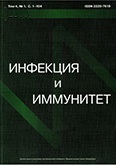THE RAPID CULTURE METHOD FOR THE INDICATION OF RABIES VIRUS ANTIGEN IN INFECTED CELL CULTURES
- Authors: Barkova E.P.1, Nagieva F.G.1, Nikulina V.G.1, Lisakov A.N.1
-
Affiliations:
- Mechnicov Research Institute of Vaccines and Sera, RAMS, Moscow
- Issue: Vol 3, No 4 (2013)
- Pages: 323-326
- Section: ORIGINAL ARTICLES
- Submitted: 08.07.2014
- Accepted: 08.07.2014
- Published: 08.07.2014
- URL: https://iimmun.ru/iimm/article/view/140
- DOI: https://doi.org/10.15789/2220-7619-2013-4-323-326
- ID: 140
Cite item
Full Text
Abstract
Abstract. The rapid culture method for the indication of antigens of rabies virus has been improved. It allows to detect the antigen of rabies virus within 5 hours from the moment the cell cultures was infected. To achieve this aim it is necessary to use cell culture BHK-F, polyclonal antirabies FITC labelled immunoglobulin and direct method of membrane immunofluorescense. Applying of twofold freshly filtrated 3% paraformaldehyde as fixing solution allows to detect early virus proteins of rabies virus.
About the authors
E. P. Barkova
Mechnicov Research Institute of Vaccines and Sera, RAMS, Moscow
Email: firaya77@gmail.com
PhD (Biology), Leading Researcher, Laboratory of Hybrid Cell Cultures, Department of Virology
РоссияF. G. Nagieva
Mechnicov Research Institute of Vaccines and Sera, RAMS, Moscow
Author for correspondence.
Email: firaya77@gmail.com
PhD, MD (Medicine), Head of the Laboratory of Hybrid Cell Cultures, Department of Virology
115088, Russian Federation, Moscow, 1st Dubrovskaya str., 15
РоссияV. G. Nikulina
Mechnicov Research Institute of Vaccines and Sera, RAMS, Moscow
Email: firaya77@gmail.com
PhD (Medicine), Leading Researcher, Laboratory of Hybrid Cell Cultures, Department of Virology Россия
A. N. Lisakov
Mechnicov Research Institute of Vaccines and Sera, RAMS, Moscow
Email: firaya77@gmail.com
Junior Researcher, Laboratory of Hybrid Cell Cultures, Department of Virology Россия
References
- Лисаков А.Н., Нагиева Ф.Г., Баркова Е.П., Никулина В.Г., Юминова Н.В., Антонова Т.П., Федотов А.Ю. Экспресс-диагностика краснушной инфекции методом прямой иммунофлюоресценции с использованием моноклональных антител к белку Е1 вируса краснухи // Инфекция и иммунитет. — 2012. — Т 2, № 4. — С. 735–740. Lisakov A.N., Nagieva F.G., Barkova E.P., Nikulina V.G., Yuminova N.V., Antonova T.P., Fedotov A.Yu. Ekspress-diagnostika krasnushnoy infektsii metodom pryamoy immunoflyuorestsentsii s ispol`zovaniem monoklonal`nykh antitel k belku E1 virusa krasnukhi [Express-diagnostic of rubella infection by the immunofluorescent assay using monoclonal antibodies to protein E1 of rubella virus]. Infektsiya i immunitet — Infection and Immunity, 2012, vol. 2, no. 4, pp. 735–740.
- Равилов А.З., Хисматулина Н.А, Юсупов Р.Х. Комплексное изучение бешенства животных и меры борьбы с ним // Ветеринария. — 2000. — № 6. — С. 7–10. Ravilov A.Z., Hismatulina N.A., Yusupov R.H. Kompleksnoe izuchenie beshenstva zhivotnykh i mery bor`by s nim [Complex study of rabies infection in animals and combating measures]. Veterinariya — Veterinary Science, 2000, no. 6, pp. 7–10.
- Фоменко М.В., Тутов И.К. Порядок и оценка результатов лабораторных исследований при диагностике бешенства // Вестн. ветеринарии. — 1997. — № 4. — С. 47–50. Fomenko M.V., Tutov I.K. Poryadok i otsenka rezul`tatov laboratornykh issledovaniy pri diagnostike beshenstva [Order and estimate of results of the laboratory research on rabies diagnostics]. Vestnik veterinarii — Veterinary Science Reporter, 1997, no. 4, pp. 47–50.
- Bordighon J., Piza A.T., Alvares-Silva M., Caporale G.M., Carrieri M.L., Kotait I., Zanetti C.R. Isolation and replication of rabies virus in C6 Rat glioma cells (clone CCL-107). Biologicals, 2001, vol. 29, no. 2, pp. 67–73.
- Dean D.J., Abelseth M.K., Atanasiu P. The fluorescent antibody test. Laboratory techhniques in rabies; eds. F.X. Meslin, M.M. Kaplan, H. Koprowski. — Geneva, 1996, pp. 88–93.
- Hendekli C.M. Current therapies in rabies. Arch. Virol., 2005, vol. 150, pp. 1047–1057.
- Knobel D.L., Cleaveland S., Coleman P.G., Fevere E.M. Re-evaluating the burden of rabies in Africa and Asia. Bull. World Health Organ., 2005, vol. 83, pp. 1–11.
- Nishizono A., Khawplod P., Ahmed K., Goto K., Shiota S., Mifune K., Yasui T., Takayama K., Kobayashi Y., Mannen K., Tepsumethanon V., Mitmoonpitak C., Inoue S., Morimoto K. A simple and rapid immunochromatographic test kit for rabies diagnosis. Microbiol. Immunol., 2008, vol. 52, iss. 4, pp. 243–249.
- Rupprecht C.E., Halon C.A., Hemachudha T. Rabies reexamined. Lancet Infect. Dis., 2002, vol. 2, pp. 327–343.
- Rudd R.S., Trimarchi C.V., Abelseth M.K. Tissue culture technique for routine isolation of street strain rabies virus. J. Clin. Microbiol., 1980, vol. 12, no. 4, pp. 590–593.
- Webster W.A. A tissue culture infection test in routine rabies diagnosis. Can. J. Vet. Res., 1987, vol. 51, no. 3, pp. 367–369.
- Winner W.H., Larson J.K., Dietzschold B., Smith C.L. The molecular biology of rabies viruses. Rev. Infect. Dis., 1988, vol. 10, suppl. 4, pp. 771–784.
- WHO Expert consultation on rabies: first report. WHO technical report series 931, 2005, Geneva, Switzerland.
- Wunner W.H. Rabies virus. In: Rabies; eds. A.C. Jackson, H. Wunner. New Jork: Academic Press, 2002, pp. 23–77.
Supplementary files







